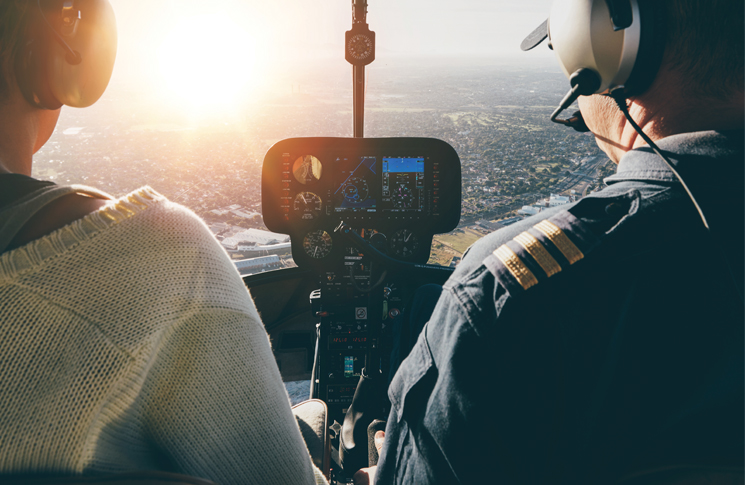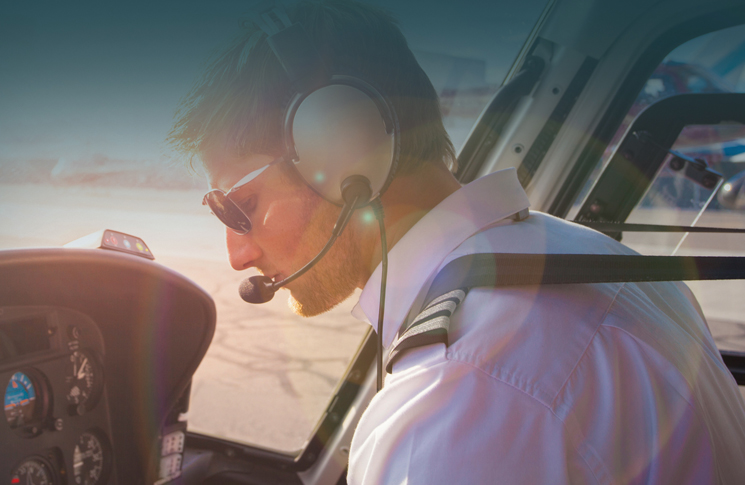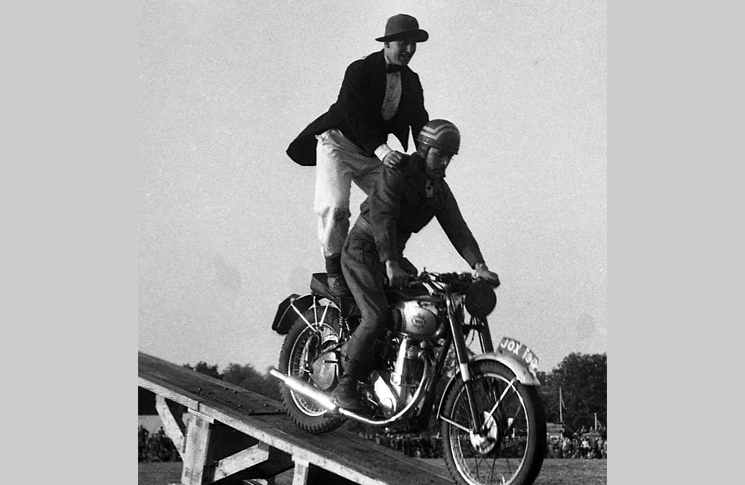by Brendan Reinhardt
A new mental model of pilot-induced oscillation brings insights that might help you stop it happening to you.
A hard-working pilot drives home from a late-night bank run in the early hours of the morning. It has been a long week and it’s been a relief to finally put the aircraft to bed and head out of the airport after midnight for a well-earned sleep. The pilot’s eyes are heavy and occasionally they close, briefly. Winding down the window should help.
The sound of gravel on tyres interrupts the reverie of incipient sleep.

image: © Jacob Lund | Adobe Stock
Reality shatters slumber as the tired pilot realises the car is drifting off the road. Impulse reactions take over as every effort is made to keep the wheels on the blacktop. A sharp tug to the right on the steering wheel sends the car back on to the road. Lucky escape! Except what are these headlights shining in my eyes! Another moment of clarity as the driver realises the car is now heading towards oncoming traffic. Now a big left swipe on the steering wheel narrowly avoids a head-on collision but now the car is back on the gravel—requiring an even bigger input on the steering wheel back to the right.
In seconds the car is swerving all over both lanes of the road as the pilot tries to avoid one side, then the other, until the tyres tuck and the car rolls over.
How easy is it to normally track the centre of the road as we are driving? There aren’t any wobbles or instability when trying to just drive beside a white line in your lane. How in this case did the driver and car lose that ability and instead end up diverging wildly from one side of the road to the other before rolling the car?
Pilot induced oscillations (PIO) are uncontrolled oscillations resulting from the efforts of the pilot to control the aircraft. The pilot’s attempts to control the aircraft end up being delayed due to pilot ability, visual cues, control system response or a combination. This delay ends up applying the control surfaces at a point in time where it is out of phase and actually adds to the adverse motion of the aircraft.
PIOs are normally best controlled by the pilot ‘getting out of the loop’, stopping their inputs and letting the aircraft’s natural dynamic stability settle things down.
Consider the pilot is aiming to maintain a constant altitude and a gust of wind disturbs the aircraft. The pilot will attempt to control a pitch response with elevator. When the nose goes up they will apply forward stick. However, the response will not be applied by the control system due to lag until the nose is on the way back down due to normal aircraft stability. This delayed control response then adds to the downward motion. As the pilot sees downward motion the pilot applies aft stick however again the response is delayed and doesn’t occur until the aircraft is pitching up. The oscillations are reinforced by pilot action and the oscillations become larger and larger if the pilot continues to make inputs. PIOs are normally best controlled by the pilot ‘getting out of the loop’, stopping their inputs and letting the aircraft’s natural dynamic stability settle things down. Aircraft designers are required to build their aircraft so that they are not susceptible to PIOs and this is tested in the certification process.
In 2005 a test pilot at Edwards Air Force Base, William Gray, published a paper on a new way to look at PIO. This was from the point of view of boundary avoidance rather than trying to maintain a central or point condition. In the boundary avoidance PIO the pilot suddenly finds themselves about to exceed a boundary that may even threaten the aircraft or pilot’s life.
This is alarming and the pilot makes a very positive input to move away from the boundary. This input is more than required and results in the aircraft moving to another boundary that also alarms the pilot and may also be dangerous. Again the pilot puts in another excessive input because of their survival instinct. Boundary PIOs are the result of successive avoidances between two opposing boundaries.
Gray outlines a simple activity of riding a bike to illustrate the condition. To ride a bicycle along a line isn’t a very hard task and most people can do it with an accuracy of around 10 or 20cm. Now put that line on a plank above a canyon where the plank is 50cm wide and suddenly the consequence of task failure becomes very high—injury or death. (Incredibly, there are people who do this for fun.)
If the bike moves slightly towards the edge the rider puts in a prompt input to head back to the centreline, as we don’t want to get close to the edge—that is where death is. The rider doesn’t moderate their input and overshoots the centreline and the process is repeated in the other direction. Instead of trying to follow a line the rider is now trying to avoid the two edges of the plank. The rider’s ‘gain’ or oscillations increase so much the system becomes unstable. Soon it is no longer just a matter of gain or workload, but a matter of survival. Under high-consequence conditions the simple task of riding along a line changes from a line maintenance task to an edge avoidance task and becomes much more difficult. And it’s the same in aviation.
It happened to me in a high performance military fixed wing training aircraft. As a student I was sent on night solo circuits with my course buddies. There were several aircraft in the circuit and on base I ended up getting too close to the aircraft in front of me. I worked out that I wouldn’t get a landing clearance so I went around on finals. The runway direction faced a major city and there was a very distinct cloud base illuminated by the city lights. Not remembering my training and being annoyed I had to go around I visually set an attitude off the cloud base and not off the instruments. The clouds were above the horizon so I had set too high an attitude.
I was suddenly caught out when I scanned the airspeed and noticed it was below climb speed and decreasing. Alarmed I might stall I pushed the stick forward and congratulated myself on picking up that error. Another glance at the airspeed saw it was now increasing but also very fast. I was now approaching the maximum undercarriage extended speed limit. I pulled back on the stick and selected idle whilst retracting the undercarriage and flap—overspeeding the undercarriage would be an embarrassing incident to explain to the instructor. Satisfied that I had averted this disaster it was time to think about flying again. I was now disappointed to see the airspeed rapidly decreasing—the next boundary was stall. I finally realised I had to look at the attitude indicator—set the climb attitude, put the power to max and waited for the engine to spool up while I reacquainted myself with the location of the ejection handle. I had entered a classic boundary avoidance PIO in an aircraft that was very stable and not prone to PIO in pitch.

It is worth noting that the boundary is a state where the pilot does not want to stay and will take positive action to exit, whereas error bands for point tracking tasks are accepted. Boundaries can consist of physical barriers such as a bird, or the ground, an aircraft limit, pilot physiological ability such as G tolerance, and performance boundaries for assessment that have a high consequence if exceeded such as a limiting altitude in a test. Student pilots doing ILS approaches often bounce off each side of the localizer bar tolerances. Pilots who have experienced boundary excursion PIO have reported stop-to-stop control inputs. PIO have traditionally been thought of with point tracking tasks and aircraft design tries to eliminate system susceptibility. Boundary tracking PIO are harder to design out of an aircraft because of the human element of fear driving large control inputs without logic. It was acceptance of this concept that showed a new PIO condition needed consideration. Fly-by-wire aircraft and automatic ground collision avoidance systems are starting to mature to a state where the aircraft may recognise the impending loss of control or ground impact and recover the aircraft for the pilot. Unfortunately, most of us will not see these systems in our flying career. So what is to be done?
The traditional advice for PIO to ‘get out of the loop’ and freeze the stick is almost impossible to do in the mind of the pilot due to fear. Hence prevention of the initial fright or surprise is the best method to counter boundary avoidance PIO. Sticking to known work cycles in the go around would have helped in my situation. Power to MCP, climb attitude on the AI, check performance, gear and flaps up. Preparation and repetition are the key to imprinting work cycles that will serve you well when you are tired, distracted or lack normal visual cues. Maintaining operational limits or buffers to avoid dangerous conditions will prevent the scare if a mistake is made.
Awareness of boundary avoidance PIO may allow some to identify what is about to occur and allow them to break the cycle before it is life threatening.
Low flying or low-level aerobatics for which you are not trained or authorised is asking for a fright. Going straight to the maximum G limit in an aerobatic aircraft without a warm up should be avoided. Incremental progression to your personal limits will allow a greater feel for what is about to happen and allow early and more gentle indications of any potential surprises. Awareness of boundary avoidance PIO may allow some to identify what is about to occur and allow them to break the cycle before it is life threatening. Getting out of the loop by reducing or stopping control inputs is still valid however you need to have the presence of mind to moderate your control inputs and maybe even accept some boundary transgression (if not critical) to slow the wild journey down.



Sorry, what is the point of posting a photo of a helicopter. It appears to be an R22 / R44, which are inherently UNSTABLE!
Over controlling in a helicopter can, and usually does, lead to a certain dearth spiral! Not much point in calling it a PIO!
“So what is to be done?”
You could have expanded the answer to this question.
But first, the main reason drivers over control the steering in the situations you mentioned is that they are not trained in front wheel drive cars. Also not trained for the correct response in rear wheel drive! And in addition, many drivers think that 4WD is a cure-all. Skids should be taught as part of the driving test.
However, having don’t all that, and learned to fly, especially tailwheel aircraft (and similarly model helicopters), the normal method of using small and quick pulses of rudder is how you control a taildragger on the ground when landing. You will overcorrect and ground loop if you don’t, sometimes you even have to increase power when you least want to, in order to get some airflow over the rudder. Enough said.
I have experienced PIO when flying a trike after a year or so of flying a very sensitive hang glider. I was flying solo in a high powered two seater and started steep turns which I couldn’t control, the just got steeper until over 90 degrees either way. I knew what was causing it and it was an effort to simply let go of the control bar and keep about 1/3 throttle, which immediately let the aircraft stabilise in level flight. For the next part of the flight I had no trouble because I only made minimum inputs in both pitch and roll, which is all you have on a trike.
So one method is to just let go of the controls and wait a bit.
We do learn to reduce and even stop control inputs when we first learn our final approach to landings. Once you have throttle, flaps, speed and glide slope set up, you almost ignore the small deviations caused by wind gusts, but it seems that this is forgotten except when in landing mode.
Another great article Brendan. Great to have a test pilot’s insights to encourage deeper reflections on the ‘how’ and ‘why’ of what we do. Looking forward to the next one.
Interesting article, but what is a “Bank Run”?
It’s 11:44 Oct 21, 2019, AM in New Orleans, La. There it’s 3:44 am Oct 22, 2019. That’s 16 hours. My understanding of the world clock must be off.AM
Joe Taylor Oct 22, 2019 at 3:40 am
Interesting article, but what is a “Bank Run”?
A direct indication of your age! Cheers.
“Bank running” is a contract freight service, mostly between country centres and cities. It usually involves the banks contracting their daily movement of supporting documentation to major freight companies, who “top up” the bank load with their own express freight, newspapers etc.